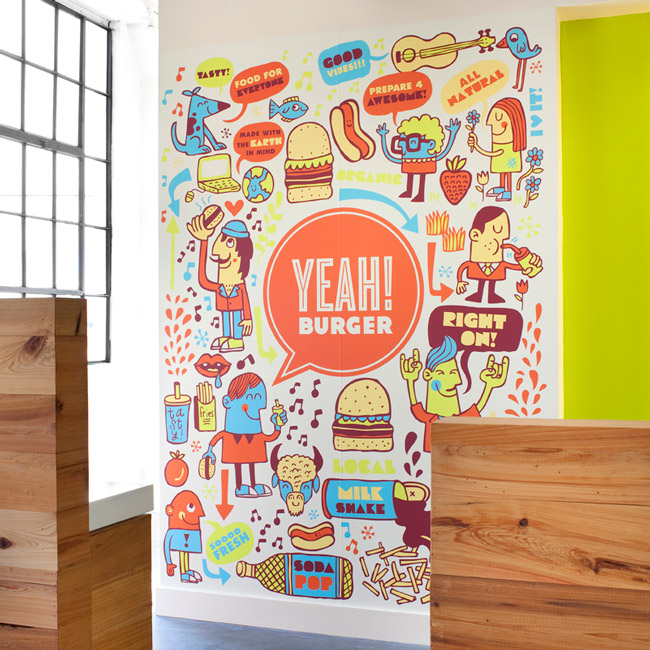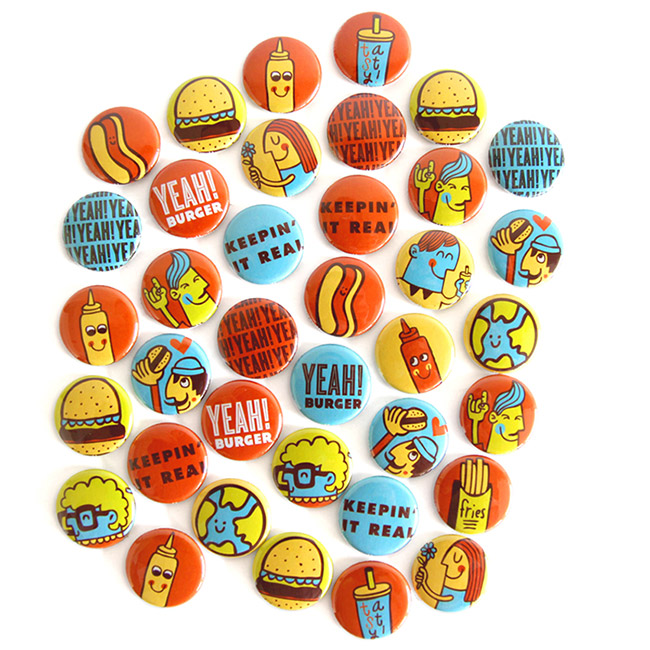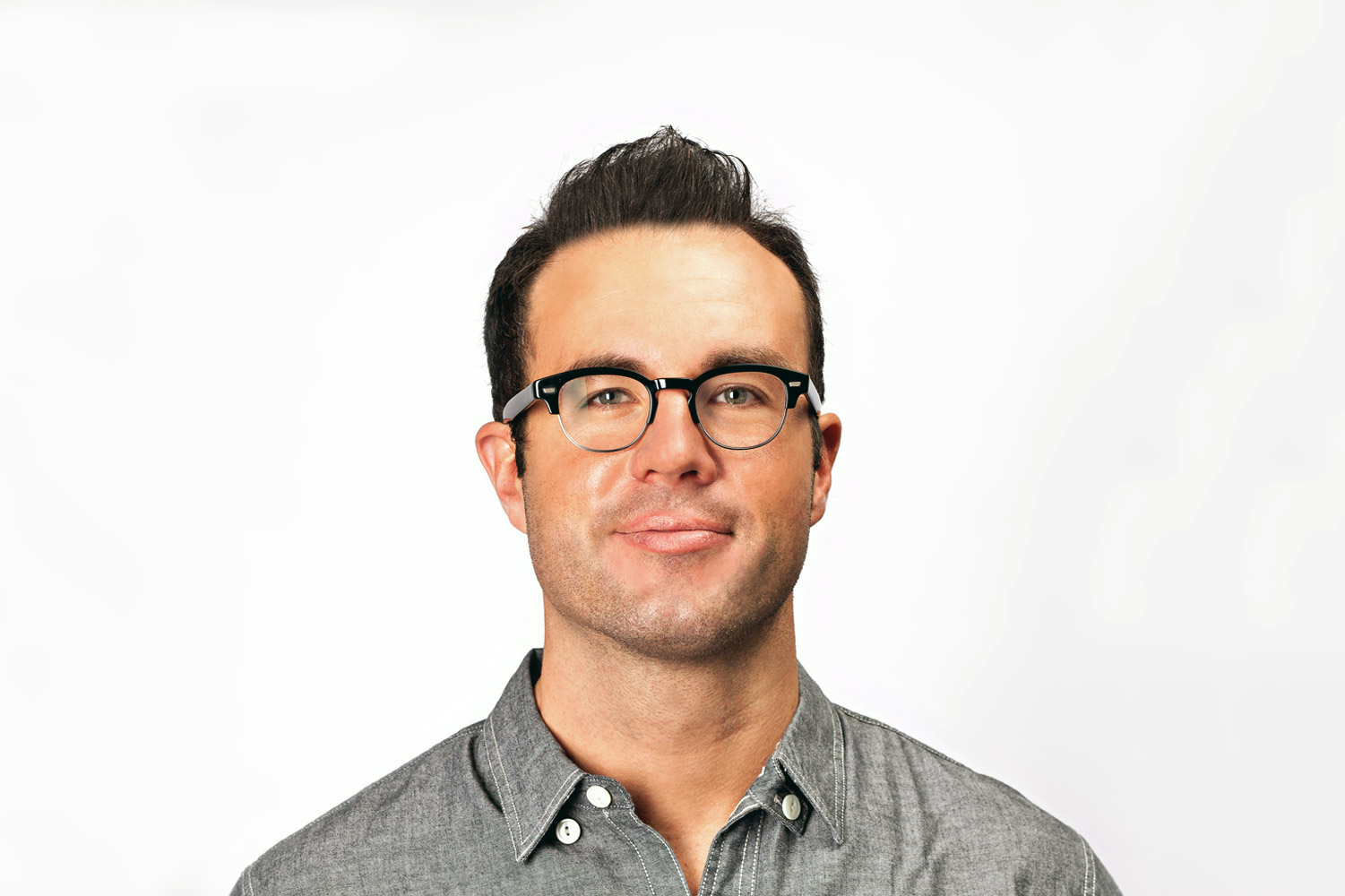
- Interview by Ryan & Tina Essmaker May 15, 2012
- Photo by Lemon Lime Photography
Tad Carpenter
- designer
- illustrator
- writer
Tad Carpenter is an illustrator, designer, and teacher living in Kansas City, Missouri. Tad runs his own studio and teaches graphic design at the University of Kansas. He has illustrated and designed several children’s books, spot illustrations, and national campaigns in our current marketplace. He has been featured in Communication Arts, Print, How, Graphis, and dozens of publications in regards to design and illustration.
Interview
Describe your path to becoming an illustrator and designer.
I was really fortunate to grow up in a household with parents who were both artists. I was an only child, or a lonely child as I thought it was. I grew up making and I never knew any different. I just thought that’s what we all did. When I went to a friend’s house who had a parent who was an accountant, I thought, “What the heck? You guys don’t sit around at night making things?” It was so surreal.
My mother is a fiber artist. She dyes her own wool and hooks these beautiful rugs. My father is an illustrator and has worked for Hallmark Cards for almost 40 years. He started as an illustrator and writer and is now Creative Director for Hallmark International.
From an early age, I had a good idea and understanding of what illustration and design were and how they were important to us. As a teenager, I rebelled and thought I wanted to be a painter for a while, but then I realized how important illustration and design were to me, especially growing up with my dad. Some sons and fathers work on cars and some do illustrations together, which is what me and my dad did. Even to this day, I run sketches by him all the time because he’s the most amazing draftsman and idea man I’ve ever met. He really set a tone for me as an illustrator and artist.
The fact that I grew up in the hallways of Hallmark Cards really shaped my voice as a designer. A lot of us think of Hallmark Cards as a place where fluffy bunnies and sentimental flower cards are created—there’s some truth to that. But outside of Pixar maybe, there’s nowhere that has this much creativity in one location.
I got to meet all kinds of people growing up there. One person was Paul Coker, who was one of the original illustrators for Mad Magazine. He was also one of the lead character designer for the abominable snowman from those claymation Christmas movies we watched as kids. I’ll never forget this; for my ninth birthday, Paul sent me a drawing of Alfred E. Neuman saying, “Hi Tad. Happy 9th birthday!” with a dog peeing on Alfred’s leg. It was brilliant and I have it hanging in my office still.
Another person I met was Gordon MacKenzie, one of my dad’s best friends. Gordon would go on to write a book called Orbiting the Giant Hairball and I highly recommend it to everyone. It’s about the benefits of creativity in corporate America. One of my favorite things that Gordon always said was, “Everyone has a masterpiece within them.”
Gordon was a great speaker and he would go to schools and present to each individual grade. He would ask students in each grade, “Who in here is an artist?” As he moved up grade levels, he would see less and less arms raise in response to his question until he got to middle school and only two hands would go up. We get older and start worrying about what we’re making, if it’s successful, and how it compares to what others are doing. Gordon inspired me to believe that you don’t need permission to be creative. It’s okay to think differently; it’s ok to be an artist; it’s ok to be an innovator.
That was a super long answer. (laughing)
That’s okay. So, did you go straight to college after high school already knowing your path or did you have any “aha” moments along the way?
When I was in third grade, I had my first real experience with illustration and commerce. I won a contest to draw the season tickets for the Kansas City Chiefs. As a third grader, I was like, “Wait a second. I will make things and you will give me things?” They gave me season tickets; they had a football player come to my school in a Ferrari to drive me around; they had a big assembly; and then, a fifth grade girl asked me out. I thought, “Illustration and design—this is where dreams come true.”
(we’re all losing it)
I left high school thinking I was going to go the art school route because I had scholarships to various art institutions. Then I realized how much I like diversity and I thought I would miss that going somewhere that only focused on art. This is strange, but I lived a double life in high school; I was captain of the football team and the art kid. I hung out with my football buddies and the art kids who dyed their hair pink.
I decided to go to the University of Kansas in Lawrence. It’s an amazing school for design. Right off the bat, I knew I wanted to make, but I didn’t know what I wanted to make. Inevitably, my family ties won out; I started doing painting which led to illustration and then to graphic design.
Did you immediately go out and do your own thing after college or did you work for an agency?
I worked for someone else. I think a lot of students want to do their own thing right out of school and now, as a teacher, I can’t recommend highly enough that they go work for someone else for at least five years. That’s a drop in the bucket when it comes to your career. The fact that someone will pay you to learn is priceless. We get out of school and we still don’t know that much, but you learn so rapidly your first year of being employed.
I did that. I worked at a smaller, boutique branding firm for five or six years. I made a conscious effort to be there longer because I wanted to be 100% ready when I went out on my own. There was a transition period where I was working full-time during the day and doing freelance work all night. I actually did that for a few years until I was plenty comfortable and busy on my own. I’ve officially been on my own for three and a half years now.
I’m a firm believer in taking risks as an artist. If you just sit back and play it safe all the time, your work’s going to be pretty vanilla and your life might be as well. I knew when it was time to break out on my own and I grabbed the reigns and did it.
“I’m a firm believer in taking risks as an artist. If you just sit back and play it safe all the time, your work’s going to be pretty vanilla and your life might be as well.”
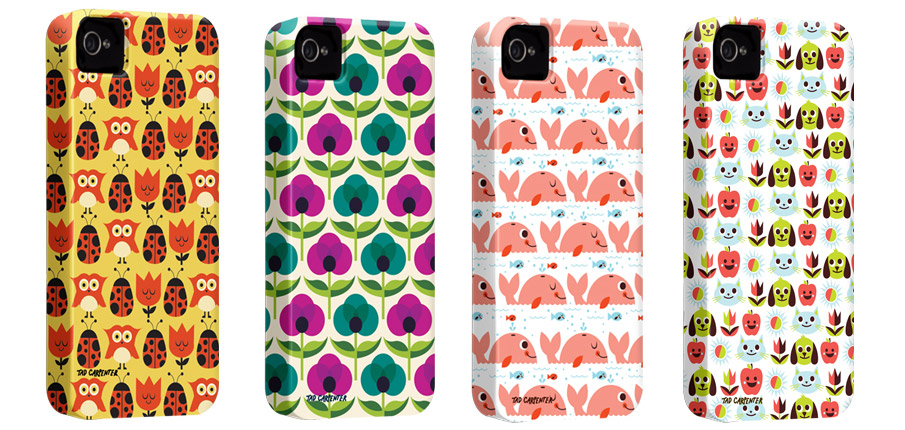
You already mentioned Gordon being an inspiration for you. Did you have any other mentors that encouraged or inspired you along the way?
Definitely my father. He is my biggest mentor, which was an amazing experience that I am so thankful for. With that said, I was basically living with an art director for twenty years of my life. (laughing) It was magnificent from a learning standpoint. I would not be anywhere without my dad’s guidance and direction, but having an art director as a dad can be interesting. I am sure most kids were having conversations with their dads about cleaning their rooms when my father and I were dissecting a project I was working on or discussing how my concept needed to improved or whatever.
(all laughing)
I was also so fortunate to know Gordon. I wish I would have known him when I was older; I was pretty young when I knew him and he passed away 10 to 15 years ago now. Those two men really stand out to me as mentors.
Was there a point in your life when you decided you had to take a big risk to move forward?
I think that for any illustrator or designer, cutting the cord to your 9 to 5 job is a risk. It’s scary and if you’re not scared, maybe it’s not for you. I think a little fear is nice motivation. I like to be a little uneasy with things because it pushes me that much harder. It’s like walking out on thin ice and asking, “Can I stand here? Okay, I can.” It keeps me on my toes. Going out on my own was definitely the biggest risk I’ve taken so far, but you have to take risks; you can’t stay in the same place all the time.
Although, my wife and I just started a new adventure, which is scaring the pants off me. We bought a plot of land and are going to build an office and home in the same location. My wife is also a graphic designer who is amazingly talented and a huge support to me; very rarely do I do anything that doesn’t get passed by her. I’ll be working in the new office and she works at branding firm here in Kansas City so she goes into their office. We’re going to design and build the space, which is very exciting.
Ryan: You mentioned your wife being creative. Tina and I are both creative and it’s awesome being married to each other and being able to run stuff past each other all the time, but there are also challenges like needing your own space to create. How does that work for you two? Or is it just easy and cool all the time?
Of course it’s never easy and cool all the time, but we’re lucky in the sense that we’re very different in the way we approach design. My wife is very detail-oriented, conceptual, organized, and has amazing typographic skills. I think I’m a lot more illustrative and whimsical. Probably a little more of an abstract thinker. There’s enough difference that we fit together really well.
There are times where we might say, “Okay, I’ve got enough direction from you.” At the same time, we’ve been together eight years now and we know each other pretty well. We know when to push and when to let it go. Also, I currently have my own office and she goes to work at her office, so there’s a physical separation. If we were working side by side everyday, I’m sure it would be a little more interesting. (laughing)
Are you satisfied creatively?
I’m comfortable creatively, but I don’t know if I’ll ever be satisfied. As far as the kind of work I’m doing and the clients I’m working with, I’m very happy. I get to work with really large clients like Target, Adobe and Macy’s, which is a dream. And I love doing start-up work, especially branding for start-ups. The projects that are most satisfying are the ones I work on from the ground up where I get to help the client figure out their voice and how to tell their story. I like to think of myself as a storyteller—literally and figuratively.
On the literal end, I’ve started to write and illustrate children’s books. Hopefully these stories remind kids that it’s okay to be kids and it’s important to play. For me, everything goes back to that. That was the one word I took away from Gordon MacKenzie—“play”. The essence of what all of us are doing is centered around play.
Is there anything you’d like to be doing 5 to 10 years from now?
I hope to continue to do more and more branding for start-ups and the children’s books that I mentioned. Those are my two distinct passions. I hope that some of the books I’m working on could become brands and continue on to other applications from merchandise to apparel to licensing. That would be really exciting.
What else? I love designing spaces and would like to do more of that. My wife and I are going to design this office and home. With some of the restaurants I’ve done work for, I’ve been able to work collaboratively with the architect to decide how my brand can impact the space and help inform and move the guests through the space, which is really fun.
I would also like to do more sculptural pieces. I love Yoshitomo Nara’s huge fiberglass sculptures and I think that would be really exciting and it’s totally out of my comfort zone. I have designed vinyl toys, but something so large would be really amazing.
“…I fell in love with teaching…I go into class and talk to students about how to think, sketch, and develop their work. I can’t go home and bullshit my way through a project after that. It makes me realize how important the process is.”
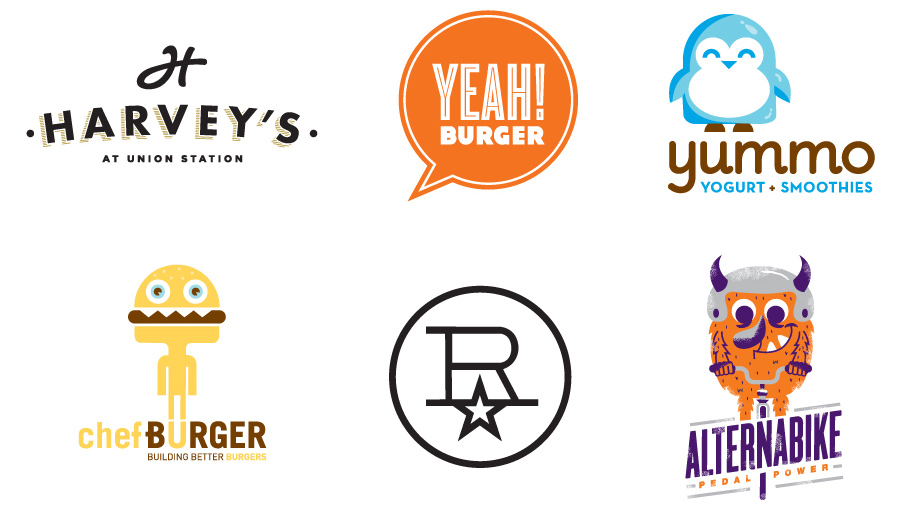
Do you feel a responsibility to contribute to something bigger than yourself?
I knew this was coming. I have no idea how to answer this. I definitely do. More than anything, I’m honored just to be a part of what we’re all doing. I get to wake up and draw and make things for people all day, everyday. That’s about as good as it gets. I am literally getting paid for what I love to do.
As far as trying to do something bigger for the greater good, I know what I’m good at and it’s not being out digging trenches and building houses. I’m a carpenter by name only, but if I can donate my services to enrich someone’s human experience or help an organization that really needs to get their message out there, that would be amazing. I can do that.
How does living in Kansas City—and the Midwest—impact you creatively?
It’s really shaped the way I think and work. Being from the Midwest—we’re not showy people. I think there’s something nice about being humble, yet confident at the same time. Being kind is so important, which I tell my students all the time. There are so many designers at our fingertips and if somebody’s a complete a-hole, why would you work with them again?
In the Midwest, we also know talent’s not enough. There are thousands of other people just as talented, which means I need to work that much harder. It’s a blue-collar part of the country and it’s where shit gets done. That work ethic is ingrained in us because we know things aren’t going to be handed to us. I think those are attributes that represent my city: we’re not showy; we act kind; and we know talent’s not enough.
It’s funny. Sometimes I think, “Man, I could be working from Egypt right now because I haven’t gone out socially in three months.” The important thing for me is that my family is here and they keep me grounded. No matter what I’m working on, they’re proud of me and they like what I am doing, but ultimately it’s not a big deal. I’d be nervous in a city where I didn’t have a support group and might get totally lost in my work.
I feel like I owe a lot to my city, which is also why I teach at the University of Kansas. There are days I don’t want to teach—when I have deadlines—but for me, it’s a little way of giving back. Once I did it, I fell in love with teaching and now, it’s just part of my practice. If I kicked that leg out from under me, I’d be worried to find out how I would stand. I go into class and talk to students about how to think, sketch, and develop their work. I can’t go home and bullshit my way through a project after that. It makes me realize how important the process is.
I love living in the Midwest. Not to mention, KC has the best barbecue in the world!
“Through making, you find yourself. The more you make, the more you identify with who you are as a designer and creator.”
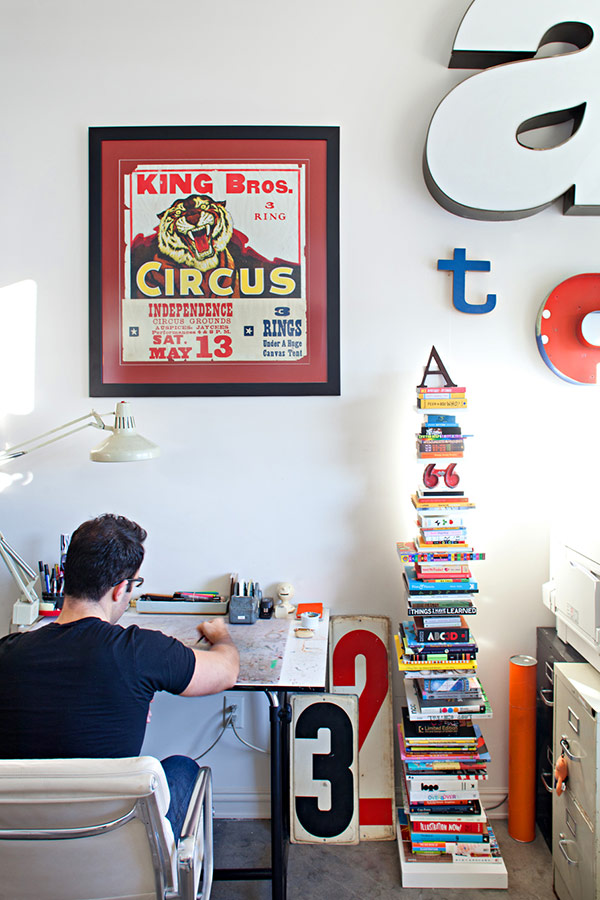
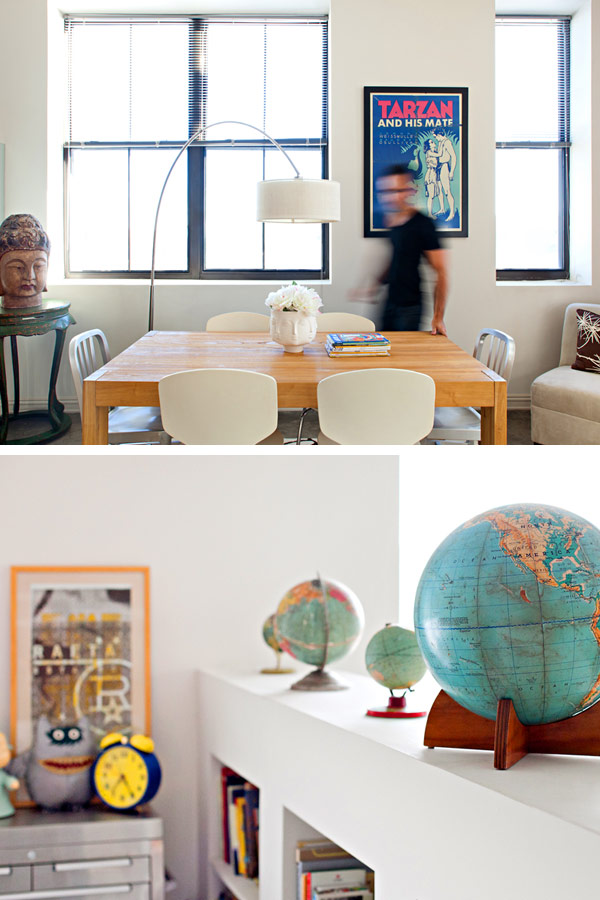
Are you part of a creative community there?
I’m always beating the drum for the KC creative community and talking to people about the amazing things going on here. I’m like the unofficial spokesperson. Ha! I am so proud of my city. It’s a seemingly smaller big town, but for the amount of people here, there’s a big creative community. Everyone you meet here is a designer, illustrator, copywriter, stylist, architect, or a photographer. I think a lot of that has to do with Hallmark being world-headquartered here. They hire people from all over the world, they move here, fall in love with the city, and they stay and move on to create other agencies and firms. It’s a hotbed for creativity right in the middle of the country.
I try to be as involved as I can. What has really helped is teaching—it instantly makes you a part of a community. Your students are looking to you for advice and guidance. I’m not getting any younger and they’re telling me things I don’t know. I’m learning just as much as they are—I guarantee that.
Also, living with a designer helps a lot. Designing in a vacuum is a horrible process and a horrible way to work. You have to share ideas and get perspective from fellow creatives. I’m lucky to live with such a talented designer.
If you could give one piece of advice to another designer or illustrator starting out, what would it be? Or, what do you say to your students?
The one thing now is that we’re all so transparent and everyone’s posting every sketch they’ve ever done. It’s overwhelming sometimes; there’s so much work to see. What I always tell my students is, “Take your time. It’s not going to come to you overnight.” Through making, you find yourself. The more you make, the more you identify with who you are as a designer and creator. Take your time to learn and enjoy the place you’re at now.
Also, in general, drop your ego. I am so passionate about what we all do, but at the same time, we’re not curing cancer. To walk into a room with a giant head and ego is extremely unattractive.
What does a typical day look like for you?
If I don’t go and work out first thing in the morning, I’m a jerk to deal with all day, so I like to get up around 6am or so and go to the gym. I start my work day around 8:30am. The quicksand that is email is right off the bat. After I get my inbox to a comfortable place, I try to get into the flow of working on projects. I don’t have a lot of face to face meetings because most of my clients aren’t in town. It’s mostly phone calls or email correspondence. I work until about 6pm or so, meet up with my wife for dinner, and hang out for a while. Then I usually go back to work in the wee hours to get a few more things done and get caught up before the next morning punches me in the face.
I only teach two days a week. Those days are totally different. My first class is at 8:30am and my second class is at 11:30am. I usually get back to the office by about 2:30pm to get back to work. On days I teach, I work pretty late because I need to still get a full days work in.
That’s about a typical day for me—total snoozefest.
Current album on repeat?
Alabama Shakes’ new album is so good. Also, the new Tanlines album. I also listen to old, old honky-tonk music—maybe that’s a Midwest thing. I have a huge playlist with Woodie Guthrie, Waylon Jennings, Kitty Wells, Wanda Jackson and of course, Johnny Cash. That music reminds me of my grandparents.
Do you have a favorite movie or TV show?
My wife makes fun of me for how much I love Friday Night Lights. We like Dexter, Breaking Bad, Mad Men, and The Walking Dead.
Favorite book?
I’d be lying if I told you I had a lot of time to read. Does that make me a terrible person? I absolutely love children’s books and there are countless ones I love. Where the Wild Things Are will always have a strong connection with me. I got to meet Maurice Sendak when I was five. I also love books by Roger Duvoisin and Bill Pete. I collect mid-century Little Golden Books with illustrators like J.P. Miller, the Provensens, and Mary Blair.
Favorite food?
I’m from Kansas City—barbecue, of course.
What kind of legacy do you hope to leave?
It’s hard to wrap your arms around that. I am a firm believer that design does enhance the human experience and that what we’re all partaking in is good. What we’re doing is fun and we’re fortunate to be a part of it. More than anything, we all must remember that we love what we’re doing. I am so thankful to be doing this for a living each day.
Whether it’s with my children’s books or my visual voice, I hope that people are reminded of the importance of play. This is something that I started doing when I was young and the fact that I hopefully get to do it all the way up until I’m 85—that’s a gift.
